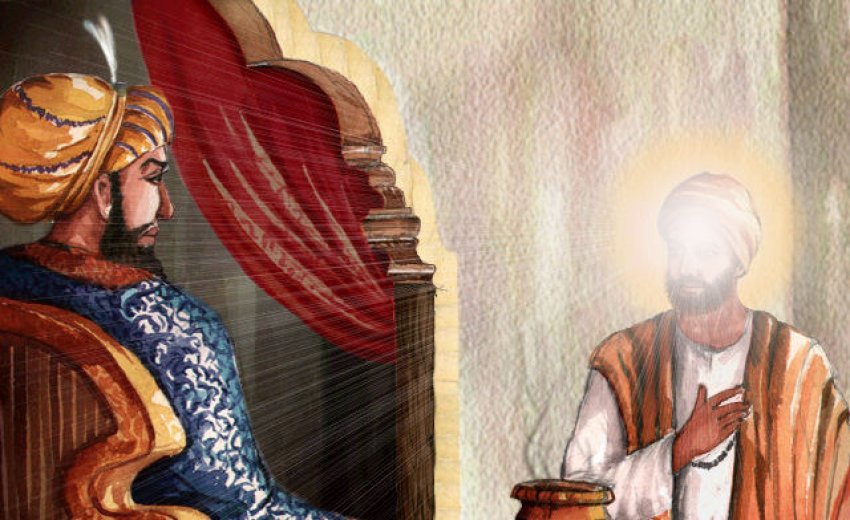-
It sometimes seems that Guru Nanak has been reduced to a caricature of himself, characterised primarily by the bazaar art that typically depicts him as a greybeard in a white or saffron turban, deep in meditation
-
Bhai Gurdas, a 17th-century Sikh poet, one of the earliest biographers of Guru Nanak, refers to him as a roaring lion in one of his ballads
-
The principle that Guru Nanak articulated when he confronted Babur was to have a profound effect on his successors and his followers
As we approach the 550th birth anniversary of Guru Nanak, the founder of the Sikh faith, I wonder what a new generation of Indians makes of him. Guru Nanak is widely respected in the Indian subcontinent as a man of peace and I suspect that most schoolchildren in the country have at least a passing sense of who he was. However, it sometimes seems that he has been reduced to a caricature of himself, characterised primarily by the bazaar art that typically depicts him as a greybeard in a white or saffron turban, deep in meditation with heavy lidded eyes that are intended to convey a sense of spiritual immersion.
It is absolutely true that Guru Nanak was defined by his spirituality and his devotion to the Divine. He was a man of peace who spent his entire life emphasising equality and tolerance, attributes that are rightly celebrated today. And yet, there were aspects to his personality that are no less significant, which have been eclipsed by this reductionist view.
Sikhs in India are generally perceived to be a valiant qaum or people. Much of this perception comes from the popular image of Guru Gobind Singh, the tenth Sikh Guru, who in sharp contrast to Guru Nanak, is often depicted as a young warrior with piercing eyes, a jet black beard, a royal aigrette on his turban and a sword in hand. This dichotomising of the first and tenth Sikh Gurus is not just an artifact created by popular art. We have a few generations of historians to thank for this, who have failed to present a holistic view of Guru Nanak to the world.
si(n)gh buke miragaavalee bha(n)nee jai na dheer dharoaa
Upon the mighty tiger’s roar restless deer flee evermore
Bhai Gurdas, a 17th-century Sikh poet, one of the earliest biographers of Guru Nanak, refers to him as a roaring lion in one of his ballads. Is this not an odd way to describe a saintly figure, known as the epitome of kindness and compassion?
The year was 1520. Guru Nanak was on his way home, his faithful companion, the minstrel Mardana in tow. The last of Guru Nanak’s great journeys, known as the udasis, had taken him to the heart of the Islamic world. He was returning from his Hajj to Mecca and had decided to halt in Sayyidpur, a town that is now called Eminabad and falls in modern-day Pakistan. Sayyidpur was home to one of Guru Nanak’s beloved Sikhs, Bhai Lalo, a humble carpenter.
A fearsome sight awaited Guru Nanak and Mardana when they arrived in Sayyidpur. The town had been attacked by the army of Babur, the Uzbek adventurer who had captured Kabul earlier and would go on to defeat Sultan Ibrahim Lodhi of Delhi and establish the mighty Mughal dynasty. The streets of Sayyidpur were awash in blood. Heaps of corpses lay everywhere and the town resounded with the anguished wails of mourning women.
Guru Nanak’s gentle soul was stirred and his anguish poured out.
jaisee mai aavai khasam kee baanee thaisarraa karee giaan vae laalo ||
paap kee ja(n)n(j) lai kaabalahu dhhaaeiaa joree ma(n)gai dhaan vae laalo ||
saram dhharam dhue shhap khaloeae koorr firai paradhhaan vae laalo ||kaajeeaa baamanaa kee gal thhakee agadh parrai saithaan vae laalo ||
musalamaaneeaa parrehi kathaebaa kasatt mehi karehi khudhaae vae laalo ||jaath sanaathee hor hidhavaaneeaa eaehi bhee laekhai laae vae laalo ||
khoon kae sohilae gaaveeahi naanak rath kaa ku(n)goo paae vae laalo ||1||As my Lord bids me to speak, thus Lalo do my words emerge
From Kabul harks a sinful groom, leading this wedding throng of doom
The lustful groom, his wedding band; in dowry they would take this land
Shame and Righteousness have died; as Evil struts in haughty prideBrahmins and the Qazis have fled; Satan, he reads the wedding vows
The women turn to the Holy Book; Allah Allah they cry forsookThe pain of every dame and lass, highborn or spawn of lowly blood
O Lalo terrible is their fate; they can’t survive this gruesome floodWhere are bridal songs of joy? Where is the fragrant saffron spray
Nanak he must sing songs of blood. On this grisly frightful wedding day
Using the metaphor of a macabre and grisly wedding, Guru Nanak cried out in pain, shaken by the barbarity he was witnessing. But it was far from an impotent cry of rage and anguish, for Guru Nanak went on to confront and upbraid the mighty invader, unmindful of the potential consequences.
raaje seeh mukadham kute ||
jaae jagaaeina baithe sute ||
chaakar nahadhaa paaeina ghaau ||
rat pit kutiho chaT jaahu ||Kings are hungry lions; their servants rabid dogs
Foes of soothing restful sleep; the mindless servile cogsThe lackeys of the evil king; waving talon and claw
They prey on common gentlefolk; their tender flesh they gnaw
This is the lion’s roar that Bhai Gurdas was talking about. Guru Nanak was slowly and meticulously building a new faith, and in confronting and excoriating Babur, he was laying down one of its fundamental principles. Tyranny and oppression were not acceptable and they had to be confronted, regardless of the cost.
Guru Nanak and Mardana were arrested and produced before Babur. The Guru’s fearless chastising of the tyrant did not stop.
khuraasaan khasamaanaa keeaa hi(n)dhusataan ddaraiaa ||
aapai dhos na dheiee karataa jam kar mugal chaRaiaa ||
etee maar piee karalaane tai(n) kee dharadh na aaiaa ||1||
karataa too(n) sabhanaa kaa soiee ||
je sakataa sakate kau maare taa man ros na hoiee ||1|| rahaau ||
sakataa seeh maare pai vagai khasamai saa purasaiee ||
ratan vigaaR vigoe kuta(n)ee muiaa saar na kaiee ||Khorasan he laid to waste
To India then he turned his gaze
How can you be blameless my Lord
Herald of death did you not raiseSlaughter death and cries of pain
How can you from pity refrainLord you are of all there is
Surely this you too can see
If warriors mighty two do fight
Reason for grief there none will beBut if the lion slays the lamb
Answer for it his master must
Dogs defile this precious land
The dead forgotten in the dustYour mysteries are beyond our ken
Let us praise your glories thenDeem themselves the mighty high
Filled with pride the foolish preen
But in your eyes, master, lord
Naught but lowly worms they’re seenForever blest, the humble, meek
Forever Nanak His name seek
The principle that Guru Nanak articulated when he confronted Babur was to have a profound effect on his successors and his followers. It was this principle that Guru Arjan, the fifth Sikh master upheld when he resisted the tyranny of the emperor Jehangir, who felt threatened by the rise of an egalitarian, non-Islamic faith that seemed to have fired the imagination of the masses.
It was this principle that inspired the sixth Sikh master, Guru Hargobind to strap on the twin swords of power and piety and raise an army of resistance and fight several battles with the armies of the emperor Shah Jahan. This very principle sent the ninth Sikh master, Guru Tegh Bahadur to Delhi to confront the emperor Aurangzeb, when the caste marks and sacred threads of the Brahmins of Kashmir were in jeopardy.
It was Guru Nanak’s roar that informed the creation of The Khalsa by Guru Gobind Singh. The sword of mercy, the kirpan that Guru Gobind Singh bestowed upon his Sikhs, an eternal symbol of their commitment to fight tyranny, was nothing but a physical embodiment of the very same principle.
Guru Nanak’s roar reverberated through the Punjab in the 18th-century, a time of great instability and turmoil, during which the people were terrorised both by Mughal governors such as Zakriya Khan and Mir Mannu as well as the invading Afghans led by Ahmad Shah Durrani. This very roar inspired the Sikhs to resist. It forged their character and brought them much pain and much glory.
As we celebrate the 550th birth anniversary of Guru Nanak, let us pause and listen, for the roar has not been stilled. May it inform our understanding of this great prophet, whose legacy is rich, profound and everlasting.
Note: The translations of verses from The Guru Granth Sahib are by the author
Sarbpreet Singh is a poet, playwright, and commentator with a career in technology. He is the author of The Camel Merchant of Philadelphia (Tranquebar/Westland Publications).

